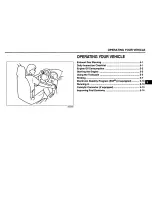
6 7
What to do in an emergency
TIRE PRESSURE MONITORING SYSTEM (TPMS, IF EQUIPPED)
(1) Low tire pressure telltale /
TPMS malfunction indicator
Each tire, including the spare (if pro-
vided), should be checked monthly
when cold and inflated to the inflation
pressure recommended by the vehi-
cle manufacturer on the vehicle plac-
ard or tire inflation pressure label. (If
your vehicle has tires of a different
size than the size indicated on the
vehicle placard or tire inflation pres-
sure label, you should determine the
proper tire inflation pressure for
those tires.)
As an added safety feature, your
vehicle has been equipped with a tire
pressure monitoring system (TPMS)
that illuminates a low tire pressure
telltale when one or more of your
tires is significantly under-inflated.
Accordingly, when the low tire pres-
sure telltale illuminates, you should
stop and check your tires as soon as
possible, and inflate them to the
proper pressure. Driving on a signifi-
cantly under-inflated tire causes the
tire to overheat and can lead to tire
failure. Under-inflation also reduces
fuel efficiency and tire tread life, and
may affect the vehicle’s handling and
stopping ability.
Please note that the TPMS is not a
substitute for proper tire mainte-
nance, and it is the driver’s responsi-
bility to maintain correct tire pres-
sure, even if under-inflation has not
reached the level to trigger illumina-
tion of the TPMS low tire pressure
telltale.
Your vehicle has also been equipped
with a TPMS malfunction indicator to
indicate when the system is not
operating properly. The TPMS mal-
function indicator is combined with
the low tire pressure telltale. When
the system detects a malfunction,
the telltale will flash for approximate-
ly one minute and then remain con-
tinuously illuminated. This sequence
will continue upon subsequent vehi-
cle start-ups as long as the malfunc-
tion exists. When the malfunction
indicator is illuminated, the system
may not be able to detect or signal
low tire pressure as intended. TPMS
malfunctions may occur for a variety
of reasons, including the installation
of replacement or alternate tires or
wheels on the vehicle that prevent
the TPMS from functioning properly.
Always check the TPMS malfunction
telltale after replacing one or more
tires or wheels on your vehicle to
ensure that the replacement or alter-
nate tires and wheels allow the
TPMS to continue to function proper-
ly.
OMD060002
UD HMA 6.qxp 4/2/2012 7:00 PM Page 7
Summary of Contents for Elantra 2013
Page 33: ...o ut s s ar r nt g e k R g er e e s er 6 ...
Page 81: ...gging 4 87 ments 4 91 atures 4 94 ystem 4 99 es of your vehicle ...
Page 84: ...4 5 Features of your vehicle of wo ful er nce n ot y d e ...
Page 151: ...n at he de n he he OMD040102A if equipped 2 ...
Page 197: ...he g he ed he od 18 ...
Page 262: ...his 2 ...
Page 323: ...pull ove 3 Install the new blade assembly in the reverse order of removal 061 OYF079062 2 ...
Page 367: ...E NOTICE ing az rs as ers ust 22 ion 6 ...
Page 377: ...I Index ge 1 ...
Page 386: ... 7 39 7 41 4 25 4 26 4 27 4 28 ng 4 87 4 90 4 89 5 42 5 42 5 43 7 30 4 66 ge 10 ...
















































